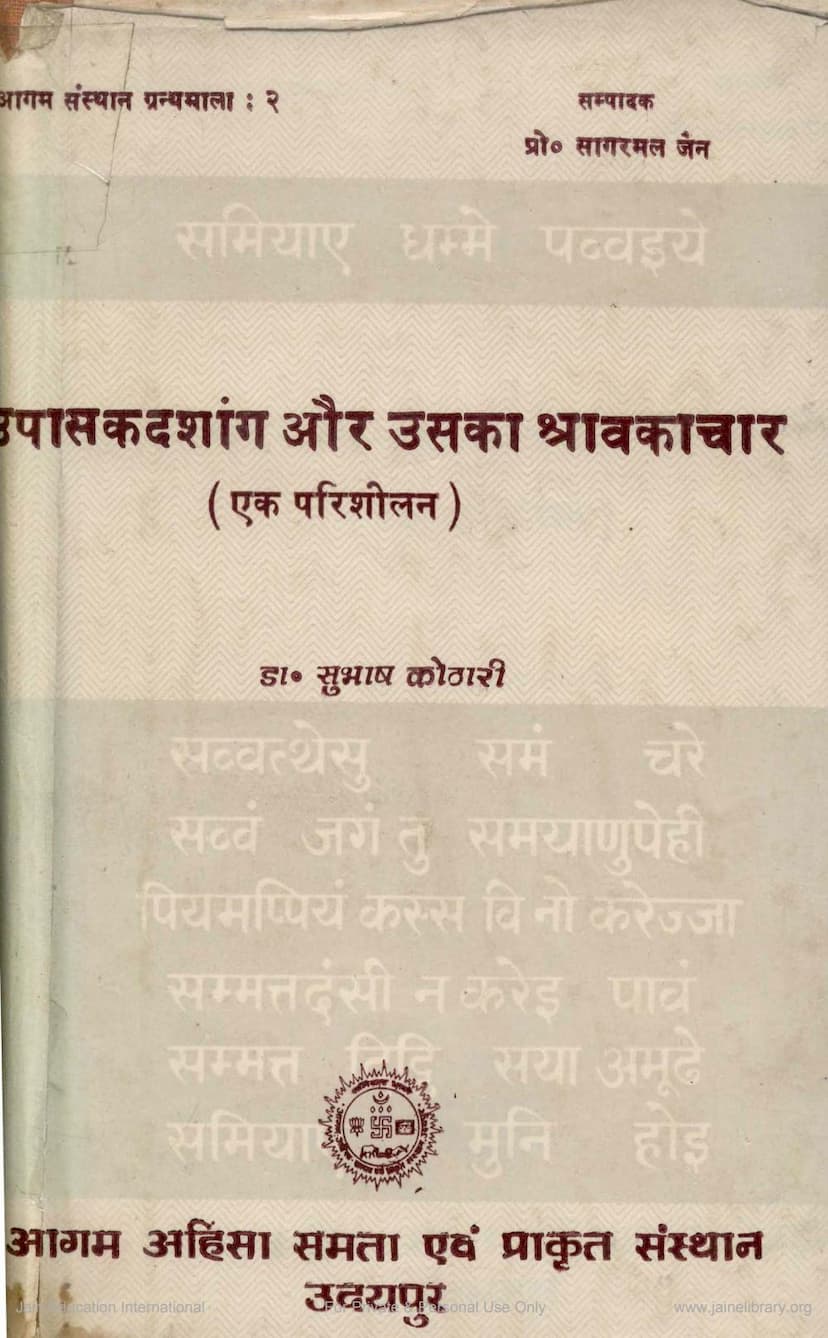Upasakdashanga Aur Uska Shravakachar
Added to library: September 2, 2025

Summary
This document is a detailed scholarly analysis of the Jain text "Upasakdashanga aur uska Shravakachar" (The Upasakdasha Anga and its Shravakachar) by Dr. Subhash Kothari. It appears to be the published outcome of his PhD research, undertaken at Agam Ahimsa Samta Evam Prakrit Sansthan, Udaipur, and awarded by Sukhadia University, Udaipur, in 1985.
Here's a breakdown of the content based on the provided pages:
Core Focus:
The book provides a critical and comparative study of the Upasakdasha Anga, a foundational Jain scripture for householder conduct (Shravakachar), in light of other Jain texts that expound upon similar principles from both Shvetambar and Digambar traditions.
Key Themes and Chapters:
The book is structured into six chapters, offering a comprehensive examination:
- Chapter 1: Agam Literature and Upasakdashanga: This chapter establishes the context by defining and discussing the nature, importance, and classification of Jain Agam literature. It covers the oral tradition, different recensions (Vachanas), and the process of canonization of Jain scriptures.
- Chapter 2: Introduction to Upasakdashanga: This chapter provides an introduction to the Upasakdasha Anga itself, detailing its available manuscripts, published editions, and commentary literature.
- Chapter 3: Subject Matter and Characteristics of Upasakdashanga: This is a central chapter that delves into the core content of the Upasakdasha Anga. It describes the lives of ten prominent householder disciples (Shravakas) – Anand, Kamdev, Chulnipita, Suradev, Cullashatak, Kundakaulik, Sakdalputra, Mahashatak, Nandini-pita, and Salhi-pita. It highlights their virtuous lives, their dedication to spiritual practice while living in the world, and the literary merits of the text, including its dialogues and psychological insights.
- Chapter 4: Period of Composition and Linguistic Analysis of Upasakdashanga: This chapter addresses the dating of the Upasakdasha Anga, suggesting a period between the 2nd century BCE and the 1st century CE. It also provides a detailed linguistic analysis, focusing on the characteristics of Ardhamagadhi Prakrit and its presence in the Upasakdasha Anga, noting influences from Maharashtri Prakrit.
- Chapter 5: Shravakachar (Householder Conduct): This extensive chapter is dedicated to the principles of Jain householder conduct as outlined in the text and compared with other traditions. It covers:
- Anuvratas (Minor Vows): Detailed explanations of the five minor vows (Ahimsa, Satya, Asteya, Brahmacharya, Aparigraha), their definitions, classifications, and associated transgressions (Aticharas).
- Guna Vratas (Substantive Vows): The three substantive vows are discussed, including their purpose in strengthening the minor vows.
- Shiksha Vratas (Progressive Vows): The four progressive vows are explained as means to further refine one's conduct and move towards spiritual liberation.
- Eleven Pratimas: The text discusses the eleven stages or vows that a householder progresses through in their spiritual journey, culminating in a state approximating monasticism. It also touches upon related concepts like Shatkarma, Shat-avashyak, Dash Dharma, and Dvadasha Bhavana.
- Chapter 6: Society and Culture in Upasakdashanga: This chapter examines the socio-cultural landscape depicted in the text. It covers aspects like:
- Social Life: Discussion of Varnas (castes) and Jatis (sub-castes), family structures (joint families, role of the patriarch), marital relationships, dowry system, and inter-family rivalries.
- Governance and Justice: Mentions of kings, administrative officers, and judicial processes.
- Arts and Sciences: References to writing, the Ardhamagadhi language, pottery, architecture, and various crafts.
- Economic Life: Details about agriculture, animal husbandry, trade (domestic and foreign), various professions, wages, profit, means of transport, and economic transactions. It also covers consumption patterns like food, beverages, clothing, and ornaments, as well as forms of entertainment.
- Religious Life: Insights into the monastic order (Shraman Sangh), their living arrangements, encountering obstacles (Upasarga) in religious practice, and adherence to other religious doctrines.
- Historical and Geographical Details: Information about cities like Champa, Vanijyagram, Varanasi, Alabhika, Kampilyapur, Polaspur, Rajgriha, Shravasti, and their geographical context. It also mentions historical figures like Mahavir, Goshala, Jitshatru, Shrenik, and Indrabhooti Gautam.
Key Contributions and Significance:
- Comprehensive Study: The book offers a thorough critical analysis of the Upasakdasha Anga, going beyond mere translation or summary.
- Comparative Approach: By comparing the Shravakachar principles with both Shvetambar and Digambar traditions, the author provides a broader perspective on Jain householder ethics.
- Linguistic and Historical Value: The linguistic analysis of Ardhamagadhi and the examination of socio-cultural details provide valuable insights into the historical context of Jainism and ancient Indian society.
- Encouragement for Research: The publisher's note highlights the book's aim to encourage young scholars in Jain Agam research.
- Financial Support: The publication was made possible by a significant grant from Ganpatrajji Bohra, highlighting institutional support for Jain scholarly work.
In essence, this work by Dr. Subhash Kothari is a scholarly treatise that aims to illuminate the significance of the Upasakdasha Anga as a key text for understanding Jain householder ethics, its historical context, and its place within the broader framework of Jain Agam literature.